June 2017 to June 2018
Australia: Out, Back, and Around
For us it will first and always be the birds. They woke us in the morning, and talked us to sleep at night. Our favorite memories all seem to include bush camping next to trees full of squawking galahs and corellas, inquisitive magpies, cockatoos and the chatty Aussie crows. And the best of them all, the king of the flock, the delightful Laughing Kookaburra, probably the best known kingfisher in the world and a delightful friend to all travelers.
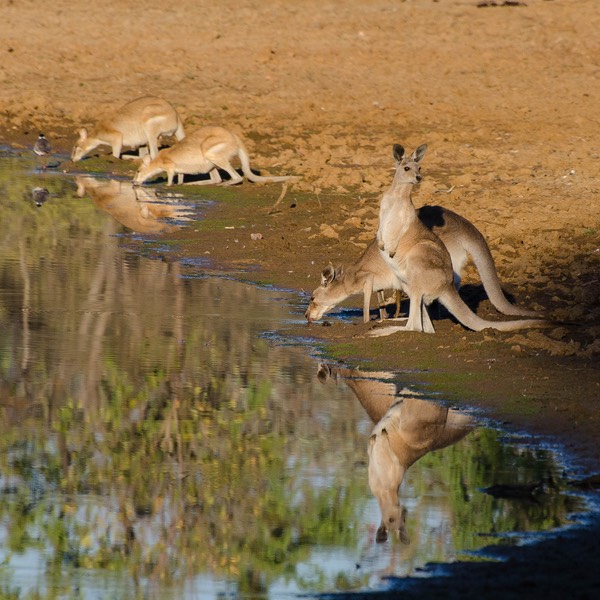
And trees. We always looked for trees to park near. Australia’s trees cover a wide spectrum, including the wild and weird boabs, but our favorites were the eucalypts — also known as gums and all part of the Myrtle family, or so we were told. There are zillions of varieties of eucalypts spread all across the continent. Different colors, different types of bark, differing sizes, but all recognizably related. The best, for us? Probably the red river gums, but we’re not really sure.
Not to be left behind are all the other wild creatures of Australia, kangaroos and wallabies of course, but also emus, koalas and wombats, lizards and echidnas and many more. There’s something about a group of kangaroos or wallabies hopping along beside you as you drive along the road that just cannot fail to bring a smile to your face. It is one of the iconic sights of this slightly odd continent; something that is not to be seen anywhere else. Add in the crocodiles, sunning on riverbanks, wild camels wandering in the desert, and Tasmanian devils — and that about sums up Australia for us.
And so we begin to paint a picture for you, a picture of what Australia means to us: A waterhole under the trees, a starry sky with the Southern Cross close enough to touch; critters ignoring our vehicle as they come to drink and the birds squawking overhead as they bid us good night and good morning and generally seem to argue over just about everything.
* * * * * * *
After spending a full year in Australia, a country roughly the size of the continental United States, we wanted to spend a little time thinking about and sharing with you our thoughts about our time there — the highlights vs. the disappointments; our great adventures and significant difficulties; the people we met and those we were unable to reach out to — what we like to call the good and the — well, not quite so good. The highlights are what we remember most, of course. There’s always more to be enjoyed than complained about in our lives.
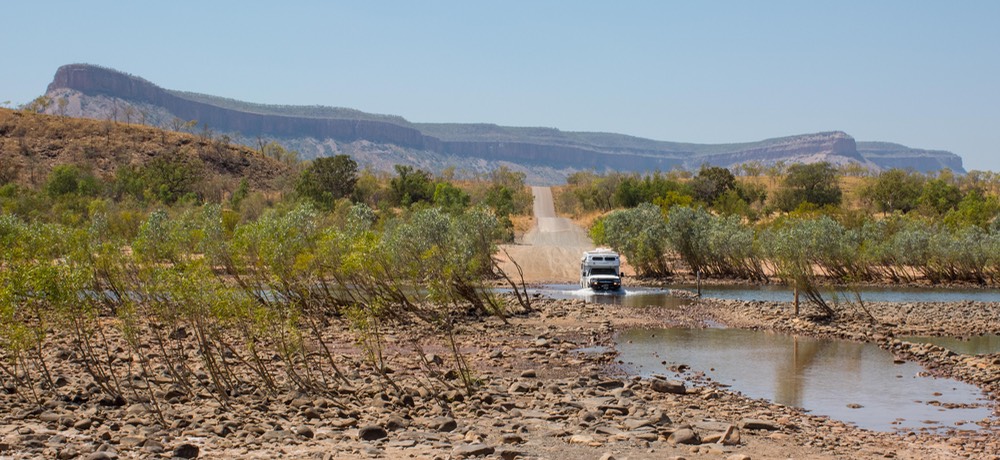
Two areas stand out for us. The desolate-appearing rural parts of the middle of the country, referred to by many as the Red Center, had great enchantment. We loved the Outback, with its huge open spaces, the occasional emu clomping along, rutted roads that caused us more trouble than we had expected, and magnificent geography to explore. There were enormous national parks set aside to protect the natural beauty of the land, indigenous sacred places and rock paintings, as well as many historically significant structures. So there was lots to see in the Outback. Oh, and we mustn’t forget those tremendous road trains, flying along day and night with up to four trailers and over ninety wheels wobbling along the narrow unpaved highway.
The coastlines were just as impressive. Australia’s beaches are well known, and deservedly so. Driving around the country’s edges is very rewarding, with the coastlines of Western Australia getting our vote as The Best of the Best.
There is one aspect of Australia that we dearly love, and it has nothing to do with natural wonders — the truly great meat pies, known in the US as pot pies. Bakeries are everywhere in this country, and the best ones seem to be in rural areas. And the whole town seems to descend on them at lunch time to buy that town’s best of the best. Always a half-dozen kinds on offer, each with its loyal purchasers — and they are all delicious. Beef, lamb, chicken, curry, potato — each with or without mushrooms or onions; large scoops of chips on hand as well. My only complaint is that everyone seems to think you have to dump a huge glop of catsup on top. Eeeuuuw!
Our favorite places? In no particular order, and called out by State or Territory — probably:
Northern Territory — Kakadu NP, with its tremendous Aboriginal presence; Alice Springs, with its really great Desert Park, and the rest of the Red Center: Kings Canyon NP, the West and East McDonnells, and the amazing Uluru and Kata Tjuta.
Western Australia — Close encounters with the crocodiles at Windjanna Gorge NP; Exmouth and Cape Person for such great sand and for teaching Kathy how to snorkel; Yanchep NP and its koalas; the entire Margaret River region, so varied and lovely; the tall trees of the southwest; Manjimup and its Cherry Festival; and Cape Le Grand NP, possibly the loveliest park in the entire country.
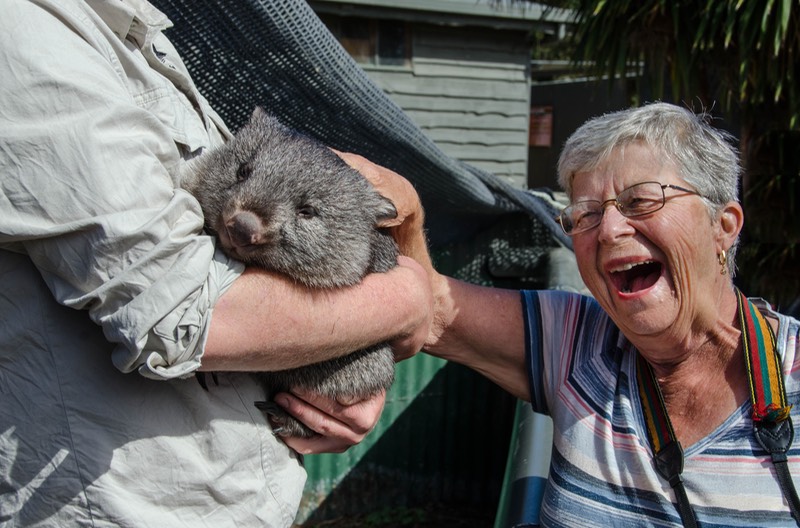
New South Wales and Victoria — who jointly share the grand country called the Alps, the highest part of the Great Dividing Range. The best of the Alps? The Snowy River and High Country.
Also in New South Wales — the many wonderful and healthy small towns in the region north of Melbourne and west of Canberra. Particularly Cowra for its United Nations Peace Bell and the preservation of its WWII history as the site of a multi-national POW camp. Also Temora for its marvelous Aviation Museum housed on the airstrip originally built for pilot training during WWII.
Tasmania — for the Natureworld Animal Rescue and Sanctuary, the rainforests and the west coast area, Mt Field NP. And the honey — as good as any, worldwide.
The city of Melbourne, which introduced us to Australian Rules Football — Footy!!! — on a day we’ll never forget.
People. In our experience we found the people to be very like Americans. Most were cheerful, happy to meet us, ready to share their country, and anxious to learn that we were having a good time. We heard little negativity towards our government — but a lot toward theirs. There were many of the same negative comments we hear at home; about not being properly attended to or how certain groups were getting pampered, or how the politicians were acting.
On the other hand, we’ve also met some really nice folks out traveling, and the people Rick met in the Perth area while dealing with truck issues were just great. Rick says he had an interesting discussion with the fellow who was in charge of the major truck repairs. He said that with the downturn in the WA economy a few years ago, they were all hurting quite badly. A decision was made that better service and more interest in the customer could help; Rick feels they have taken excellent care of us and he’s been really pleased with the interaction. This experience stood out because, in general, customer service does not seem to us to be very good in Australia.
On the flip side, describing the local population as being a lot like Americans cuts both ways. While we admire the hardy pioneer spirit still very evident in those who live in small towns or on remote stations way out in very harsh country, coming into urbanized areas quickly reminds you of home: the same traffic, crowding, fast pace, and frequent disregard for the rights of others. For us as travelers, we found that the things that can be called uniquely Australian are found in the countryside and small towns of the interior and not in the cities (those wonderful state museums excepted, of course).
A couple of related observations would be that being a pedestrian in Australia is neither enjoyable nor likely to be life-prolonging. We were told that pedestrians have the right of way in Australia, but never actually experienced it ourselves.
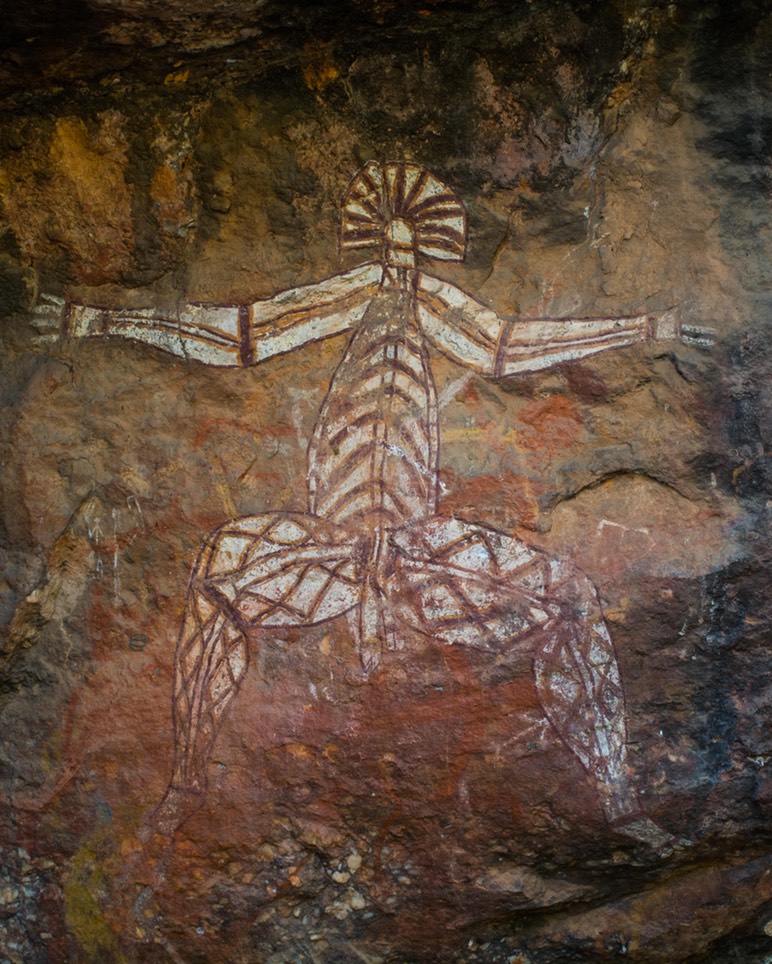
The Aborigines. The Aboriginal situation and our interactions with them have given us much to talk about. Their numbers and outward demeanor vary considerably depending on location. Throughout most of the country, you see almost no Aborigines at all and the ones around are often kids in school, workers in the mall, and maybe a few well dressed folks in the stores. They act just like everyone else.
We’ve found more Aborigines in outlying, rural, isolated areas such as mining country and in the north. There are large populations in the Northern Territory, particularly in Alice Springs and east of Darwin, for example. They are trying hard to maintain their separate ways, don’t appear to like the white folk very much, don’t want to interact, and seem to really dislike tourists. If they are speaking among themselves in town, they can be loud, pushy and seem to want to make a negative impression on outsiders. But we have mingled with them occasionally, with pleasantries exchanged.
However, in some places the integration appears to go well; we’ve been to several really superb national parks where the indigenous people of the area have a large involvement; Kakadu, Karijini and Mungo are great examples. They are three of the best run national parks, with some of the best literature and facilities, that we’ve been to… and we’ve been to a lot of them.
Australia continues to struggle with coming to grips with the issues of its original occupants. The first comparison to come to mind might be the history of African-Americans in the US, but unlike in the United States, where we enslaved foreigners and brought them to our country, in Australia, the Aborigines were here first, in some places documented as far back as 50,000 years. Thus the comparison with America is much closer to how we have treated our own native population. America did (is still doing) a very bad job; in our minds, Australia has done even worse.
Sadly, most parks almost ignore the former Aboriginal presence. Almost all of the present day national parks have been developed on former indigenous land, which was taken from them when it proved valuable to the government or to white settlers. There is usually a single sign with a comment acknowledging who the historic owners were and that their rights are being respected; that’s about it. In recent years the government has begun an effort to rename many parks, returning them to the names used by Aborigines for perhaps thousands of years before the white settlers arrived. We encountered some push back from older whites muttering about these changes. For less enlightened residents, life in Australia seems to have begun with the arrival of European settlers about 1800.
To illustrate, we’ve done our best to recreate a wonderful information display meant to represent the timing of the arrival of the white man in Australia; we saw it at Mungo National Park. Our line drawing (below) is just an approximation, not totally accurate and not nearly as expressive as the painted panel, which shows 200 human figures in varying postures walking across from left to right, with each figure representing ten generations, perhaps 200 years of indigenous presence in the area (it has been documented at Mungo as over 40,000 years). The pointing finger tells you when the first Europeans arrived.
☟
||||||||||||||||||||||||||||||||||||||||||||||||||||||||||||||||||||||||||||||||||||||||||||||||||||||||||||||||||||||||||||||||||||||||||||||||||||||
National parks. We had something of a love/hate relationship with Australia’s national parks, exceptional though many of them are. Lots are free, but some are quite expensive, and in some areas you must book ahead in order to obtain a campsite. Everyone complains about the same thing, though: they may be called national parks, but they are run by the various states, and each has its own way of doing things. (This is also true of various other aspects of the country, such as paperwork, insurance, etc.) Each state is its own fiefdom. In some states you can purchase various kinds of park passes, while in others entry is controlled separately at each park. There is no pass that covers the entire country. It can be difficult to maneuver through the process, but in the end we managed fine.
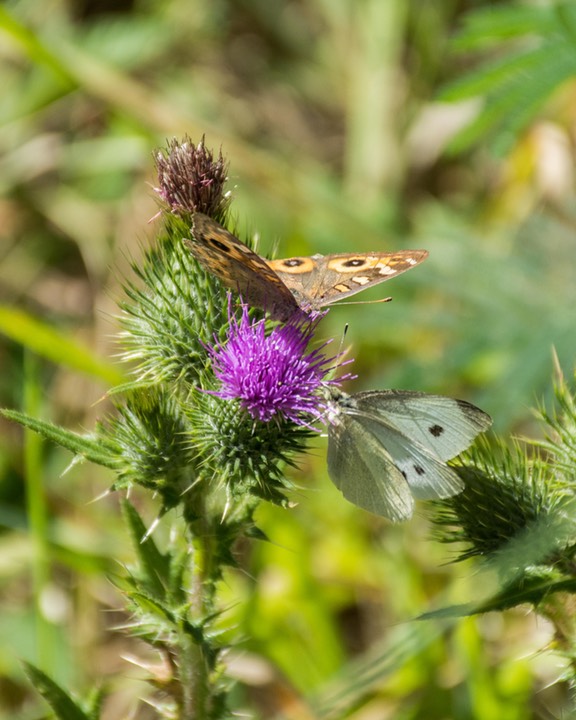
To balance out the confusion surrounding the national parks, the tourist offices you find just about everywhere are well organized, filled with useful information and brochures they want to share, contain tons of employees who know tons of info about anything you can imagine, and are bright, lovely places to stop — complete with plenty of toilets! We were never disappointed.
Also, a large percentage of the towns we visited had areas set aside for spots for casual campers just passing through and who wanted to stay the night. A very friendly and helpful country, we would say.
Roads. There’s no need to complain about road conditions in Australia, so we won’t. This a large country with a small population, fully 89% of which live in urban areas. Not surprisingly then, roads in the outback are fairly primitive and not maintained to a very high standard. To an extent, this is part of the enormous charm of travel in the outback, but still it is noticeable. In areas with larger populations roads are better. Please don’t misunderstand: we’ve not lost any of our love for tiny dirt and gravel roads that go to strange and remote places — but we have gained a healthy respect for what they can do to our vehicle’s body parts!
* * * * * *
We’d love to chat more, but we’re running off to catch up with our Tiger, which is off cruising the high seas again, this time on a ship that will shortly land in Durban, South Africa. But we’d like to leave you with the following important life questions, because, really, what do you do when you find that —
Nobody Really Knows
- What is the difference between kangaroos and wallabies?
- How many species of eucalypts/gums/myrtles are there anyway?
- If one corella is a pet, why are 100 corellas a pest?
- How much moo poo do you actually get for $2.00?
- If Australia comes off DST and the United States begins, what is the net time difference between San Francisco and Melbourne?
- What are the actual ‘Rules’ of the loosely named Australian Rules Football?
Rick and Kathy Howe, smiling with happy memories of a grand adventure